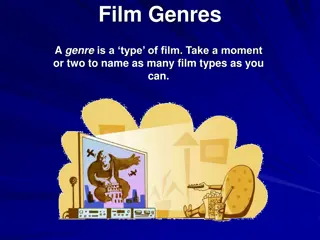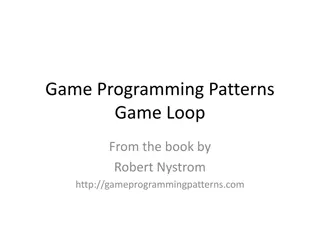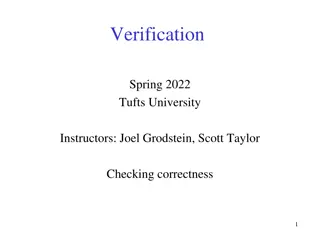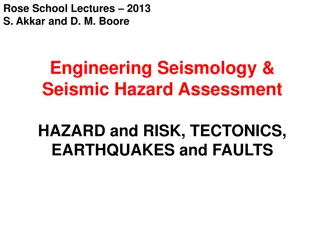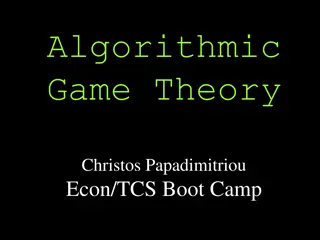Exploring Computer Game Genres in Lectures
Delve into the diverse world of computer game genres through a series of informative lectures. Discover the unique qualities of action games, subgenres, design elements, and strategic challenges. Learn about offensive and defensive units, technology trees, logistics systems, artificial opponents, role-playing game mechanics, and character attributes. Gain insights into creating immersive worlds, experience points, character levels, and gameplay modes within role-playing games.
Download Presentation

Please find below an Image/Link to download the presentation.
The content on the website is provided AS IS for your information and personal use only. It may not be sold, licensed, or shared on other websites without obtaining consent from the author. Download presentation by click this link. If you encounter any issues during the download, it is possible that the publisher has removed the file from their server.
E N D
Presentation Transcript
L Computer Games Lecture #2 Genres of Computer Games
Objectives Identify the qualities that set action games apart from other genres Recognize the distinct subgenres of action games and their particular features Use the characteristic features of action games, such as levels, lives, and powerups, to design games of your own Know the design limitations imposed by placing the player under time pressure Lecture #2 Genres of Comp. Games 2
Objectives (Cont.) Know the definition of a strategy game and be familiar with the types of challenges that strategy games offer Define the set of orders that a strategy player will be able to give in your game Design a balanced set of units for use in a war game, including defining the attributes that govern their behavior Lecture #2 Genres of Comp. Games 3
Objectives (Cont.) Compute the relative values of offensive and defensive units Understand Lanchester s laws and how they affect the relative strengths of forces of different size Create a technology tree of upgrades for the units that you have designed Lecture #2 Genres of Comp. Games 4
Objectives (Cont.) Choose a system of logistics for your game and design the mechanism by which it works Know the most common types of artificial opponents and their strengths and weaknesses Lecture #2 Genres of Comp. Games 5
Objectives (Cont.) Know the definition of role-playing games and the game mechanics common to them Understand the history and evolution of role- playing games from tabletop to computer Design character attributes for a role-playing game Lecture #2 Genres of Comp. Games 6
Objectives (Cont.) Define a world and setting suitable for a role- playing game Understand the use of experience points and character level for this genre Know the different gameplay modes within this genre Lecture #2 Genres of Comp. Games 7
Objectives (Cont.) Know the definition of athletic sports games and be familiar with the types of challenges that these types of sports games offer Understand the challenges of meeting players expectations about a real-world game in a video game implementation Lecture #2 Genres of Comp. Games 8 8
Objectives (Cont.) Know the basics of adapting a physical sports game mechanic to a virtual world Understand the design complexities for physics, AI, and player skill ratings required for a sports game Use flowcharting to help define AI states within a sports game Lecture #2 Genres of Comp. Games 9 9
Objectives (Cont.) Know the issues involved in licensing sports organizations, teams, and players, including the use of names and images Understand mapping known physical game play mechanics to computer-human interface devices Lecture #2 Genres of Comp. Games 10 10
What Are Action Games? An action game is one in which the majority of challenges presented are tests of the player s physical skills Puzzle-solving, tactical conflict, and exploration challenges are often present as well Fastest action games are called twitch games Lecture #2 Genres of Comp. Games 11
Action Game Subgenres Shooters Most familiar and popular subgenre Players use a ranged weapon 2D shooters Top-down or side-view perspective Players are under constant attack so shoot everything Unlimited ammunition Unrealistic physics Lecture #2 Genres of Comp. Games 12
Action Game Subgenres (Cont.) Shooters (cont.) 3D shooters Cutting edge of game hardware Physics are more realistic than 2D shooters Can be first-person or third-person perspective Further subgenres: Rail-shooters Tactical shooters Survival horror Arena games Lecture #2 Genres of Comp. Games 13
Action Game Subgenres (Cont.) Platform games Cartoonish games in which an avatar moves through a vertically exaggerated environment, jumping on and off platforms Most actions are jumps Highly unrealistic physics Most 2D side-scrolling games with humanoid avatar are platform games Super Mario Bros. is the classic example Lecture #2 Genres of Comp. Games 14
Action Game Subgenres (Cont.) Fighting games Physical challenges test reaction time and timing Simulate hand-to-hand combat May use a few ranged weapons Two major categories: one-on-one and m l e. Serious boxing games usually classed as sports games Actions include maneuvering, attacking, and defending Combo moves are common Play is largely 2D in the plane of the video screen Lecture #2 Genres of Comp. Games 15
Action Game Subgenres (Cont.) Fast puzzle games Require player to solve problems quickly Simple, abstract, limited control set Tetris is the archetypal fast puzzle game Casual gamers enjoy this subgenre Ideal for handheld devices and cell phones Lecture #2 Genres of Comp. Games 16
Action Game Subgenres (Cont.) Action-adventure Hybrid combines action and adventure Games include physical challenge, story, inventory, and dialog Dance and rhythm games Challenges player s sense of rhythm Press buttons to make the avatar dance Specialized hardware common: dance mat, conga drums, maracas Popular with girls less pointless violence Lecture #2 Genres of Comp. Games 17
Action Game Subgenres (Cont.) Other action games No shooting, hand-to-hand fighting, or abstract puzzle-solving Use skills such as maneuvering and path planning Lecture #2 Genres of Comp. Games 18
Game Features Progression Levels usually completed in linear sequence Levels often grouped by theme and end with a boss Fixed challenges are easier to build, but repetitious If killed, avatars reappear at a checkpoint Level exits, level warps, and teleporters Level exits lead to the next level Level warps exit the level and jump ahead several levels Teleporter jumps within the same level Lecture #2 Genres of Comp. Games 19
Game Features (Cont.) Planning your pacing: 1. Brainstorm ideas for moments of excitement 2. Order ideas by priority 3. Create a story framework 4. Rate key events for intensity, and sequence them 5. Rate and sequence story plot points 6. Set the time between high-intensity events 7. Evaluate the trends 8. Begin constructing levels 9. Iteratively test, review, and adjust Lecture #2 Genres of Comp. Games 20
Game Features (Cont.) Challenges Avatars typically faced by three kinds of problems Passive obstacle impedes movement without threat (wall) Stationary danger attacks approaching avatar (electric fence) Active dangers attack and move around Lecture #2 Genres of Comp. Games 21
Game Features (Cont.) Challenges (cont.) Waves enemies attack in groups The big boss guards the end of the themed level Wildcard enemies break up the predictability Locked doors partition levels and control progress Monster generators or spawn points cause new enemies to appear Lecture #2 Genres of Comp. Games 22
Game Features (Cont.) Player actions Routine actions include maneuvering an avatar, aiming and shooting, collecting and selecting, manipulating objects, and fighting moves Smart bomb clears enemies from the immediate area Hyperspace escape immediately moves the player at the risk of unexpectedly entering a dangerous area Lecture #2 Genres of Comp. Games 23
Game Features (Cont.) Core mechanics are simple and obvious Lives provide several reprieves from death Energy is replenished by collectibles or powerups Powerups increase strength Collectibles are common but not required Increase the score Unlock secret levels or cause special bonus events Lecture #2 Genres of Comp. Games 24
Game Features (Cont.) Core mechanics (cont.) Timer counts down time to events and catastrophes or the amount of time left to finish the level Score indicates progress Lecture #2 Genres of Comp. Games 25
Game Features (Cont.) Victory conditions Only arcade (or arcade-like) games don t have victory conditions Including a structured story means the game will end Interaction model Avatar is most common Puzzle manipulation model (Tetris) or omnipresent model (Lemmings) also used Lecture #2 Genres of Comp. Games 26
Game Features (Cont.) Camera models 2D camera models Includes side-scrolling and top-scrolling perspectives Continuous, variable, and parallax scrolling 3D first person is tied to the avatar with a limited field of view 3D third person lets the player see the avatar Many offer both, switchable at player option Resident Evil 4 combines these somewhat, moving camera to just behind avatar s shoulder Lecture #2 Genres of Comp. Games 27
Game Features (Cont.) Camera models (cont.) Gameplay implications of 2D and 3D In 3D, it is difficult to tell the speed or distance of objects that come directly toward the player 3D games use the environment to present challenges In 3D, enemies can hide and sneak up on the avatar Context-sensitive models Camera moves depending on the circumstances Not a good model for fast action games Sudden changes of camera position are disorienting during high-speed action Lecture #2 Genres of Comp. Games 28
Game Features (Cont.) User interface features Display only as much as the player needs to know Keep it onscreen Use indicators rather than numbers or text Draw attention to critical information Maps and mini-maps can be shown as transparent overlays; keep them simple Use color to identify characters and objects Controls should be as simple as possible Lecture #2 Genres of Comp. Games 29
What Are Strategy Games? The majority of challenges are strategic conflict Player chooses from a variety of potential actions or moves at most points in the game Victory is attained by superior planning and taking the best actions; chance must not play a large role Other challenges may also be present; physical challenges play little or no part Lecture #2 Genres of Comp. Games 30
Game Features Two main subgenres Classical turn-based games Pure strategy games tend to be turn-based In multiplayer turn-based computer games, players often choose their next move simultaneously Real-time strategy games Developed after turn-based games RTSs add time pressure to strategy games Lecture #2 Genres of Comp. Games 31
Game Features (Cont.) Challenges Strategic conflict Conflict is combat between groups of units Factories generate more units Players can choose from among a variety of units Diplomacy and espionage offer alternatives to combat Lecture #2 Genres of Comp. Games 32
Game Features (Cont.) Challenges (cont.) Exploration challenges Allow players to investigate unknown territory Fog of war unexplored areas shown in black, and explored but unpatrolled regions shown dimly Economic challenges Players can collect resources to buy units If the economy is complicated, the game is actually a hybrid of a strategy game and a construction and management game, e.g. the Civilization series Lecture #2 Genres of Comp. Games 33
Game Features (Cont.) Player actions involve giving orders to units Move to a location Attack Stop moving Hold a position Establish a formation Produce new units Retreat, dash, and patrol are variants of these Lecture #2 Genres of Comp. Games 34
Core Mechanics Designing units Units usually fall into types so that all units of a type share a set of attributes Some units will also have special unique capabilities Rock-paper-scissors (RPS) model is suited only to simple games Cannot be balanced for complex game Doesn t take into account battlefield conditions Lecture #2 Genres of Comp. Games 35
Core Mechanics (Cont.) Designing units (cont.) Modern war games use numeric attributes to describe unit s abilities Numeric attributes used more often are: Health Weapons Range Shot mass and velocity (or power) Accuracy Defensive dodging Speed Turn rate Mass and acceleration Range of vision Lecture #2 Genres of Comp. Games 36
Core Mechanics (Cont.) Designing units (cont.) Special capabilities include: Stealth Flying or sailing Repair Transport Constructing buildings and production of mobile units Leadership For every special capability you create for one side, you must also create a capability of similar military value for the other side OR a way to defeat the special capability Lecture #2 Genres of Comp. Games 37
Core Mechanics (Cont.) Designing units (cont.) Computing the relative value of units Value based on time and resources Equation for attack units: Attack unit value Equation for defensive units: Defense unit value = maximum health shot power rate of fire theoretical accuracy (range2 2) = maximum health shot power rate of fire theoretical accuracy range maximum speed Lecture #2 Genres of Comp. Games 38
Core Mechanics (Cont.) Designing units (cont.) Production rates, unit numbers, and Lanchester s laws Lanchester s Linear Law: In hand-to-hand combat, the relative strengths of two armies are simply proportional to their numbers of troops Lanchester s Square Law: For units that can aim and shoot at one another from a distance and can concentrate their fire, the strength differential is proportional to the square of their sizes Lecture #2 Genres of Comp. Games 39
Core Mechanics (Cont.) Health, morale, and fighting efficiency Units normally fight at full efficiency until their health points are gone If you allow efficiency to be harmed by poor health, the feedback loop will cause injured units to die very quickly Morale is represented by a number that increases or decreases an army s fighting effectiveness Morale also usually produces too much feedback Leadership bonus works better, because leadership is unaffected by health or morale. Lecture #2 Genres of Comp. Games 40
Core Mechanics (Cont.) Upgrades and technology trees Researching upgrades Player must initiate research Organize upgrades into a sequence Allow player to choose which upgrade to research Upgrades can be applied to single units, unit types, or globally Upgrades can be temporary or permanent Create a technology tree to organize large numbers of upgrades Lecture #2 Genres of Comp. Games 41
Core Mechanics (Cont.) Logistics Management of supply: the production, distribution, maintenance, and replacement of personnel and materials Strategy games usually have simplified logistics Supplies and consumable items Don t track food and fuel If ammo is cheap and quickly expended, provide unlimited supply Highly destructive ammo should be rare and tracked Lecture #2 Genres of Comp. Games 42
Core Mechanics (Cont.) Logistics (cont.) Supply lines Route over which fresh troops and war materiel must be transported from their source to where they are needed Cutting the supply line is a classic strategy Most computer war games model movement of troops accurately, but not materiel such as fuel and ammo Players don t want to manage supplies Realistic supply lines mean creating transport units and modeling the supplies as individual objects Lecture #2 Genres of Comp. Games 43
Core Mechanics (Cont.) Logistics (cont.) Abstracting the distribution process A supply is magically available wherever it is needed Completely abstracting distribution can cause exploits Alternative is verifying that supply routes are open, but don t actually require transport Road-building Build roads to access resources Roads provide supply routes Towns with no road cannot receive supplies Lecture #2 Genres of Comp. Games 44
Core Mechanics (Cont.) Logistics (cont.) Influence maps Any unit within a certain distance from a supply depot can receive supplies Unobstructed route not required Lecture #2 Genres of Comp. Games 45
The Game World Historical settings Military strategy games tend to be set in the past Historical setting will be scrutinized for accuracy by players familiar with the event World War II market oversaturated Need a less popular time period or unique approach Lecture #2 Genres of Comp. Games 46
The Game World (Cont.) Modern settings Risks generating controversy and negative public opinion Must be rigorously accurate and politically neutral Some use modern, but fictitious, settings to avoid this Must address the issue of battlefield scale A battlefield scaled for fighter planes would take weeks for infantry to walk across. One solution is to exclude units that don t fit the scale, i.e. leave infantry out of games about fighter planes Lecture #2 Genres of Comp. Games 47
The Game World (Cont.) Future (science fiction) settings Popular and allow a lot of scope for invention Might not catch public s imagination Use technology carefully Define terminology Must address the issue of battlefield scale again Lecture #2 Genres of Comp. Games 48
The Game World (Cont.) Fantasy settings Use magic rather than technology More emphasis on close-range and hand-to-hand combat Lecture #2 Genres of Comp. Games 49
The Presentation Layer Interaction model Almost always multipresent Large scale player indirectly controls units and has godlike view of the game world Squad scale smaller group of 20 individual units Camera model Players need to see the big picture Aerial perspective needed Lecture #2 Genres of Comp. Games 50








